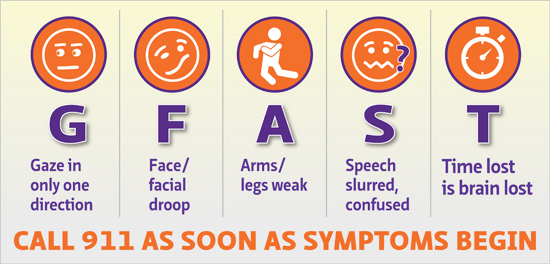
Stroke is defined as a sudden disruption in blood flow caused by a blockage or bleeding of a blood vessel. The effects of a stroke may be mild or severe and temporary or permanent, depending on which brain cells are damaged, how much of the brain is involved, and how quickly the blood supply is restored to the area. Areas of the brain affected by the blockage or bleeding can be damaged within minutes.
“If you think you’re having a stroke, it’s important to seek care immediately rather than to wait,” explains Jenelle Jindal, MD, medical director of the Stroke Program at El Camino Hospital. The sooner you get to the hospital, the more chance you have to get a medication called tPA, tissue plasminogen activator, which helps dissolve the clot blocking blood flow. If the clot is big enough, you might also be eligible for advanced therapies where a metal stent is placed into the clogged artery, and then we can trap the clot and pull it out.
The key to surviving and recovering from a stroke is to get emergency medical help quickly. The common saying “time is brain” refers to the fact that up to two million brain cells die during every minute of a stroke. Knowing the signs and symptoms of a stroke can help save your life or the life of a loved one. The quicker you recognize the symptoms and call 9-1-1, the more treatment options are available and the less damage may occur.
“It is important to remember that a stroke comes on suddenly, it is not typically something that starts out mild and gradually worsens,” notes Sherril Hopper, MSN, FNP-C, ANVP-BC, NVRN-BC, CNRN, advanced neurovascular nurse practitioner at El Camino Hospital. “We like to use the acronym GFAST as it reminds us of the most recognizable and common symptoms of stroke.”
Be fast to seek emergency medical care at the sudden onset of the GFAST symptoms.

Calling 9-1-1 activates an emergency medical system that ensures specialized treatment of a stroke. Once EMTs arrive on scene, they conduct an assessment, test blood sugar and can provide oxygen to help with breathing. En route to the nearest emergency room, the EMTs call ahead to alert the emergency room staff that a patient with stroke symptoms is on the way and provide an estimated time of arrival so the hospital can call a stroke alert.
At El Camino Hospital, when a “Stroke Alert” is called, a multidisciplinary team of emergency medicine doctors and nurses, lab technicians, imaging services (radiology) technicians, and other ancillary staff members gather in the ambulance bay to await the arrival of the patient. Upon arrival, the patient is immediately assessed by emergency medicine doctors and nurses and simultaneously, a neurologist is paged, a lab draw is completed and an EKG, chest x-ray and a CT scan are performed.
After the rapid test results and scan are interpreted, the neurologist determines the proper course of treatment. Our goal is to provide personalized stroke treatments within 45 minutes upon arrival. Treatment options are largely based on the time the symptoms started. We cannot emphasize enough how important it is for the treatment team to receive this information. We urge all patients and/or witnesses to be prepared to immediately provide this information.
To learn more about stroke and how to recognize signs and symptoms, and its treatment options, visit www.elcaminohealth.org/services/neurological-care/specialty-programs/stroke-care.
Skip
Pat's Story
Last spring, Pat was working in her garden when she began feeling strange. She wasn’t in pain, but she suddenly didn’t feel like herself and got a little dizzy. She thought she could just lie down for a minute and feel better. Fortunately for Pat, her son was there that day and said, “We’re going to the hospital.”
En route to the emergency room, Pat’s speech became jumbled and her vision became abnormal. It seemed like the cars on the road were driving straight towards the vehicle.
When Pat arrived at the hospital, she described her symptoms to the Emergency Room staff and learned she was experiencing the symptoms of a stroke. The emergency team called a stroke alert and had her on a gurney in a matter of minutes. Tests and scans were quickly performed indicating Pat was having a stroke. The team moved quickly to administer a clot dissolving drug called tPA which dissolved the clot in her neck and restored the blood flow to her brain. Luckily for Pat, she received emergency medical care immediately and is now back to gardening and golfing. Watch her story.
This article first appeared in the May 2017 edition of the HealthPerks newsletter and was updated in May 2018.

